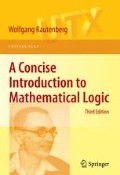Abstract
Mathematics and some other disciplines such as computer science often consider domains of individuals in which certain relations and operations are singled out. When using the language of propositional logic, our ability to talk about the properties of such relations and operations is very limited. Thus, it is necessary to refine our linguistic means of expression, in order to procure new possibilities of description. To this end, one needs not only logical symbols but also variables for the individuals of the domain being considered, as well as a symbol for equality and symbols for the relations and operations in question. First-order logic, sometimes called also predicate logic, is the part of logic that subjects properties of such relations and operations to logical analysis.
Linguistic particles such as “for all” and “there exists” (called quantifiers) play a central role here, whose analysis should be based on a well prepared semantic background. Hence, we first consider mathematical structures and classes of structures. Some of these are relevant both to logic (in particular model theory) and to computer science. Neither the newcomer nor the advanced student needs to read all of 2.1, with its mathematical flavor, at once. The first five pages should suffice. The reader may continue with 2.2 and later return to what is needed.
Access this chapter
Tax calculation will be finalised at checkout
Purchases are for personal use only
Notes
- 1.
Here r and f represent the general case and look different in a concrete situation. Relation symbols are also called predicate symbols, in particular in the unary case, and operation symbols are sometimes called function symbols. In special contexts, we also admit n = 0, regarding constants as 0-ary operations.
- 2.
\((\exists \vec{b}\in {A}^{\langle n\rangle })(h\vec{a}=h\vec{b}\ \&\ {r}^{\langle \mathcal{A}\rangle }\vec{b}\,)\) abbreviates ‘there is some \(\vec{b} \in {A}^{\langle n\rangle }\) with \(h\vec{a} = h\vec{b}\) and \({r}^{\langle \mathcal{A}\rangle }\vec{b}\)’. If \(h\:\mathcal{A}\rightarrow \mathcal{B}\) is onto (and only this case will occur in our applications) then (S) is equivalent to the more suggestive condition \({r}^{\langle \mathcal{B}\rangle } =\{ h\vec{a}\mid {r}^{\langle \mathcal{A}\rangle }\vec{a}\}\).
- 3.
Since rkφ < rk ∀xφ, we may assume according to the recursive construction of σ that \({\varphi }^{\langle \tau \rangle }\) is already defined for all global substitutions τ.
- 4.
Since this equation is to mean \(\text{ {\it free}}\,\varphi \subseteq \{ x1,\ldots ,xn\}\), \(\vec{x}\) is not uniquely determined by φ. Hence, the phrase “Let \(\varphi = \varphi (\vec{x})\ldots \)” implicitly includes along with a given φ also a tuple \(\vec{x}\) given in advance. The notation \(\varphi = \varphi (\vec{x})\) does not even state that φ contains free variables at all.
- 5.
A suggestive way of writing “X ⊨ α, β implies X ⊨ α ∧ β,” a notation that was introduced already in Exercise 3 in 1.3. A corresponding notation will also be used in stating the properties of ⊨ on the next page.
- 6.
Consistent mostly refers to a logic calculus, e.g., the calculus in 3.1. However, it will be shown in 3.2 that consistency and satisfiability of a theory coincide, thus justifying the word’s ambiguous use.
References
_________ , Introduction to Logic and to the Methodology of Deductive Sciences, Oxford 1941, 3⟨{ rd}⟩ ed. Oxford Univ. Press 1965 (first edition in Polish, 1936).
A. Tarski, Der Wahrheitsbegriff in den formalisierten Sprachen, Studia Philosophica 1 (1936), 261–405 (first edition in Polish, 1933), also in [Ta4, 152-278].
D. Hilbert, P. Bernays, Grundlagen der Mathematik, I, II, Berlin 1934, 1939, 2⟨{ nd}⟩ ed. Springer, Vol. I 1968, Vol. II 1970.
Author information
Authors and Affiliations
Corresponding author
Rights and permissions
Copyright information
© 2010 Springer Science+Business Media, LLC
About this chapter
Cite this chapter
Rautenberg, W. (2010). First-Order Logic. In: A Concise Introduction to Mathematical Logic. Universitext. Springer, New York, NY. https://doi.org/10.1007/978-1-4419-1221-3_2
Download citation
DOI: https://doi.org/10.1007/978-1-4419-1221-3_2
Published:
Publisher Name: Springer, New York, NY
Print ISBN: 978-1-4419-1220-6
Online ISBN: 978-1-4419-1221-3
eBook Packages: Mathematics and StatisticsMathematics and Statistics (R0)

